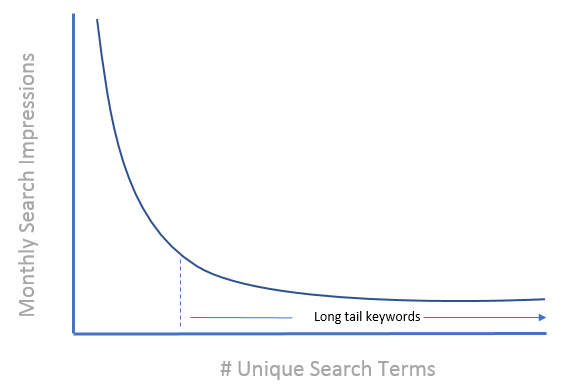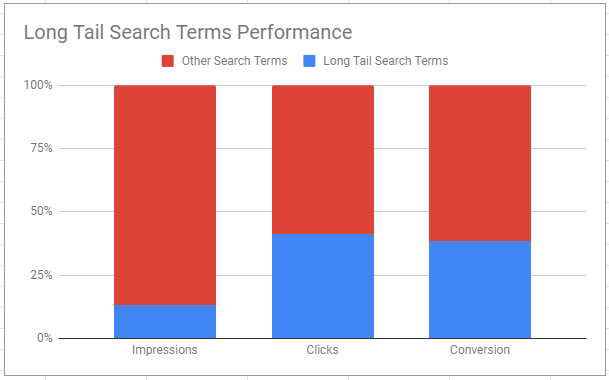Long Tail keywords have long got the support to be made a part of one’s PPC strategy. But is it an effective way to reach your target audience?
First things first, What are long-tail keywords?
The common assumption is that long-tail terms are those search terms that have a word count of 3+. However, Chris Anderson, who coined the term, had long defined it as
The theory of the Long Tail is that our culture and economy is increasingly shifting away from a focus on a relatively small number of “hits” (mainstream products and markets) at the head of the demand curve and toward a huge number of niches in the tail.

The same theory applies for long-tail search terms in paid search. These would be terms with a low search volume and the number of search terms with low volume are larger in number. So, it means that the number of search terms with higher search volume are few and thus the competition is very high as everyone would be bidding for it. It also means that the term can be a one-word term too, but is rare in nature and bearing the characteristics as discussed above.
So, knowing this, will adding a long tail search term as a keyword make much of a difference? The only reason why you would want to make it a part of your PPC strategy is to show your ads for such rare terms too.
So, should you be bidding on these terms?
But, before answering that, a few stats!
We analyzed the search terms data from one of our accounts and found that the long tail search queries were able to generate 38% of the total conversions and accounted for 6% of the total impressions. Of the total clicks received 41% of the clicks, came from long-tail search terms.

Not that the long-tail keywords would have less of an impact, but their consolidated impact might be limited. In order to get the most out of even these rare terms, you could do as discussed in the conclusion of this post.
But, before that, we discuss some reasons in detail of why adding the long-tail keywords may no longer be that effective as presumed:
Low Reach = Lower Impressions
Ideally, a long tail keyword, being a niche keyword, will cater to a more relevant audience and a lower competition than a short tail keyword. But being a rare keyword makes its reach limited. The number of user searches met are few and impressions generated even fewer. Spending on these low volume keywords will not help you drive the traction you wish for. The odds of such keywords becoming a winning one is one in a million.
Match Type Fuss
An exact match type will make the reach even more limited. And it might be too optimistic to think that users will search for exactly the same query. The same will tend to occur in the case of phrase match too.
Rather it is better to add these keywords as broad match or broad match modifier match type. This might help you approach the search terms better. Not that, that will guarantee a good performance, but at least you will be able to deliver some results if not any.
For example for the following long-tail search terms
- fitness training programs for men
- home fitness training
- body fitness training program
- fitness training routine etc.
You could instead add fitness training as broad (fitness training) or broad match type (+fitness +training)
But, while using these match types, you need to make sure to track the search terms being catered to. This is to avoid your ads from getting triggered for unrelated search queries. The next step will be to make such unwanted terms as negative keywords.
Note: Karooya’s Negative Keywords Tool for Google Ads provides Negative keyword recommendations while saving 10-20% of your search spend for free. This tool is now Free for accounts with ad spend less than $10,000 per month. Sign up and start saving your ad budget now.
Will You Really Save Money?
We commonly assume that using long tail keywords will help avoid money crunch. That might be the case, however, the reason for saving money would be because your ads aren’t getting triggered much. The question here is, do you wish to save money and not show at all, but spend wisely and generate the clicks?
So, what should you do next?
To make long tail keywords work for you, you must add it in the combination of short tail keywords and as Broad or BMM match type.
You might be interested to know that, even though, Google answers trillions (really!) of search queries every year, 15% of the search terms are completely new every day. Some of these searches might get matched to existing phrase or modified broad match keywords. You need pure broad match keywords to be able to match some of the new and relevant search terms.
This ensures that you are able to generate traffic for both popular as well as niche search terms. While also ensuring that your long tail keywords are not restricted because of the match type assigned to it.
You could possibly use a bid automation strategy for these terms so that you can hit your campaign objective, while simultaneously controlling the irrelevant inflow with the usage of negative keywords.
Related Links:





Stop the wasted ad spend. Get more conversions from the same ad budget.
Our customers save over $16 Million per year on Google and Amazon Ads.